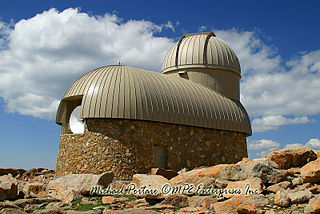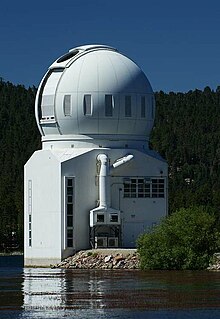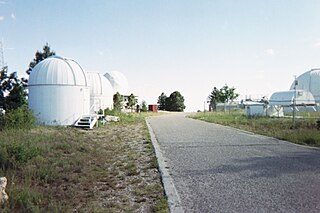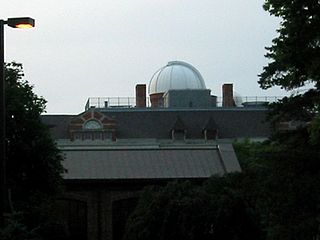
The Cerro Tololo Inter-American Observatory (CTIO) is an astronomical observatory located on Cerro Tololo in the Coquimbo Region of northern Chile, with additional facilities located on Cerro Pachón about 10 kilometres (6.2 mi) to the southeast. It is approximately 80 kilometres (50 mi) east of La Serena, where support facilities are located. The site was identified by a team of scientists from Chile and the United States in 1959, and it was selected in 1962. Construction began in 1963 and regular astronomical observations commenced in 1965. Construction of large buildings on Cerro Tololo ended with the completion of the Víctor Blanco Telescope in 1974, but smaller facilities have been built since then. Cerro Pachón is still under development, with two large telescopes inaugurated since 2000, and one in the early stages of construction

The Association of Universities for Research in Astronomy (AURA) is a consortium of universities and other institutions that operates astronomical observatories and telescopes.

Heber Doust Curtis was an American astronomer. He participated in 11 expeditions for the study of solar eclipses, and, as an advocate and theorist that additional galaxies existed outside of the Milky Way, was involved in the 1920 Shapley–Curtis Debate concerning the size and galactic structure of the universe.

The MDM Observatory is an optical astronomical observatory located adjacent to Kitt Peak National Observatory on Kitt Peak, west of Tucson, Arizona, in the United States. It is owned and operated by the University of Michigan, Dartmouth College, Ohio State University, Columbia University, and Ohio University. The Massachusetts Institute of Technology (MIT) was also part of the operating consortium in the past.

Meyer–Womble Observatory (MWO) is an astronomical observatory owned and operated by the University of Denver. It is located near the summit of Mount Evans in the Arapaho National Forest approximately 60 kilometers (37 mi) west of Denver, Colorado (USA). At an elevation of 4,326 meters (14,193 ft), it is the third-highest optical/infrared observatory in the world, and was the highest until the Indian Astronomical Observatory opened in 2001.

Mount Laguna Observatory (MLO) is an astronomical observatory owned and operated by San Diego State University (SDSU). The telescope was operated in partnership with the University of Illinois at Urbana-Champaign (UIUC) until 2000. MLO is located approximately 75 kilometers (47 mi) east of downtown San Diego, California (USA) on the eastern edge of the Cleveland National Forest in the Laguna Mountains on the SDSU Astronomy Campus near the hamlet of Mount Laguna. MLO was dedicated on June 19, 1968, seven years after SDSU's Department of Astronomy became an independent academic department of SDSU's College of Sciences. The dedication took place during the 1968 summer meeting of the Astronomical Society of the Pacific. Currently SDSU is working with University of Kansas (KU), and UNC Chapel Hill on various projects.

The Royal Observatory, Edinburgh (ROE) is an astronomical institution located on Blackford Hill in Edinburgh. The site is owned by the Science and Technology Facilities Council (STFC). The ROE comprises the UK Astronomy Technology Centre (UK ATC) of STFC, the Institute for Astronomy of the School of Physics and Astronomy of the University of Edinburgh, and the ROE Visitor Centre.

Big Bear Solar Observatory (BBSO) is a university-based solar observatory in the United States. It is operated by New Jersey Institute of Technology (NJIT). BBSO has a 1.6-meter (5.2 ft) clear aperture Goode Solar Telescope (GST), which has no obscuration in the optical train. BBSO is located on the north side of Big Bear Lake in the San Bernardino Mountains of southwestern San Bernardino County, California, U.S., approximately 120 kilometers (75 mi) east of downtown Los Angeles. The telescopes and instruments at the observatory are designed and employed specifically for studying the activities and phenomena of the Sun.

Mount Lemmon Observatory (MLO), also known as the Mount Lemmon Infrared Observatory, is an astronomical observatory located on Mount Lemmon in the Santa Catalina Mountains approximately 28 kilometers (17 mi) northeast of Tucson, Arizona (US). The site in the Coronado National Forest is used with special permission from the U.S. Forest Service by the University of Arizona's Steward Observatory, and contains a number of independently managed telescopes.

Michigan State University Observatory is an astronomical observatory owned and operated by Michigan State University. It is located south of the Michigan State University campus in East Lansing, Michigan (USA), near the corner of Forest Rd and College Rd. It has a Cassegrain telescope in its single dome. Built by Boller and Chivens, the Michigan State University telescope was commissioned in 1969 and entered regular operation in 1970. In 1974, what was at the time a state-of-the-art Raytheon Microcomputer was installed to function as a data gathering and control system. Originally, single channel photoelectric photometry and photography using plates or film were the means of acquiring data. The observatory was closed from 1981 until 1986, at a time when the university was having financial difficulties. It was reopened in the spring of 1986 on the occasion of the return of Comet Halley and has been in regular operation ever since. Since the 1980s, a CCD camera has been employed as the main instrument and the Raytheon computer has been retired. The International Astronomical Union has assigned the MSU Observatory identification code 766.

The University of Illinois Astronomical Observatory, located at 901 S. Mathews Avenue in Urbana, Illinois, on the campus of the University of Illinois Urbana-Champaign, was built in 1896, and was designed by Charles A. Gunn. It has been listed on the National Register of Historic Places since November 6, 1986, and on December 20, 1989, was designated a National Historic Landmark.
The McMath-Hulbert Solar Observatory is a solar observatory in Lake Angelus, Michigan, USA. It was established in 1929 as a private observatory by father and son Francis Charles McMath and Robert Raynolds McMath and their friend, Judge Henry Hulbert. In 1932 the observatory was deeded to the University of Michigan which operated it until 1981, at which time it was sold into private ownership again.

The Detroit Observatory is located on the corner of Observatory and Ann streets in Ann Arbor, Michigan. It was built in 1854, and was the first scientific research facility at the University of Michigan and one of the oldest observatories of its type in the nation. It was designated a Michigan State Historic Site in 1958 and placed on the National Register of Historic Places in 1973.

Fuertes Observatory is an astronomical observatory located on the North Campus of Cornell University in Ithaca, New York. The observatory was designed by L.P. Burnham, Cornell Professor of Architecture and completed in fall of 1917. It was originally used by the Civil Engineering Department as an instructional field office for navigation and surveying. Today, the observatory is primarily used for public outreach, welcoming over two thousand visitors per year with open houses on clear Friday nights.

The Peach Mountain Observatory (PMO) is an astronomical observatory owned and operated by the University of Michigan (UM). It is located near the village of Dexter, Michigan (USA), about 20 kilometers (12 mi) northwest of Ann Arbor. It was opened in 1955, and is used for research, instruction, and amateur observing.
The Portage Lake Observatory (PLO) was an astronomical observatory owned and operated by the University of Michigan (UM). It was located near the village of Dexter, Michigan (USA), about 20 kilometers (12 mi) northwest of Ann Arbor. Construction at the site began in 1948, and the facility was closed in 1975.
The Lamont–Hussey Observatory (LHO) was an astronomical observatory owned and operated by the University of Michigan (UM). It was located in the city of Bloemfontein, Free State, South Africa. Construction at the site began in 1927, and the facility was closed in 1972.

Angell Hall is an academic building at the University of Michigan in Ann Arbor, United States. It was previously connected to the University Hall building, which was replaced by Mason Hall and Haven Hall. Angell Hall is named in honor of James Burrill Angell, who was the University's president from 1871 to 1909.

Sherzer Observatory is an astronomical observatory located on the campus of Eastern Michigan University. The observatory was established in 1903 with the construction of the new Natural Science Building, in Ypsilanti, Michigan. Following a devastating fire in 1989 a new observatory opened in September 1991 with a 10-inch (250 mm) apochromatic refractor telescope and German equatorial mount centered under a 6-meter dome.

The Embry–Riddle Observatory is an astronomical observatory owned and operated by Embry-Riddle Aeronautical University, Daytona Beach. Hosting an array of optical instruments, this observatory is situated on the roof of the College of Arts and Sciences building in Daytona Beach, Florida.


















